This page has moved. You are being redirected its new location.
Left Turn Traffic Calming is a citywide program focused on reducing left turn speeds and enforcing safe turning behavior. The program is part of the overall Vision Zero initiative to eliminate traffic fatalities, severe injuries and reduce the number of traffic injuries.
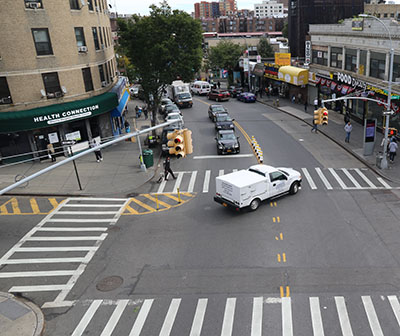
DOT selects feasible locations after checking against several criteria involving crash injury numbers, lane configuration and effect on large vehicles’ turning movements. Read more about the Left turn Study. The office of Research, Implementation & Safety manages the program and installed treatments on 107 citywide intersections in 2016, 110 intersections in 2017 as well as 113 in 2018.
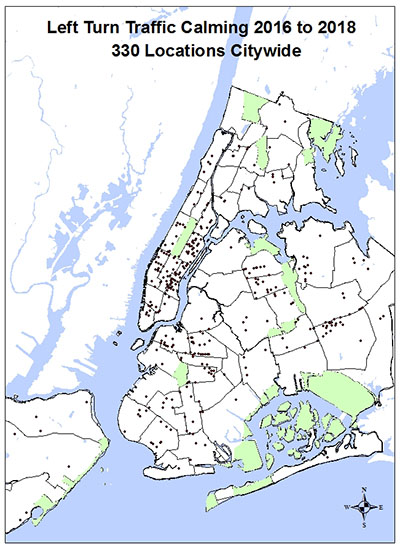
DOT selects feasible locations after checking against several criteria involving crash injury numbers, lane configuration and effect on large vehicles’ turning movements. View a list of Left turn Traffic Calming installations across New York City’s five boroughs
Also view an interactive map of all 2016 to 2018 citywide Left Turn Traffic Calming installations along with other relevant safety information.
Left Turn Traffic Calming treatments are installed in a variety of intersection configurations, but in all cases these treatments are designed to address problematic left turns
Basic Hardened Centerline
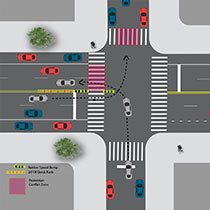
The Basic Hardened Centerline treatment constists of 6 pieces of rubber curb and bollards installed on the centerline starting from the crosswalk. Starting in 2016, this treatment was installed at 129 locations to date including West End Ave & 96 St in Manhattan.
Complete Hardened Centerline
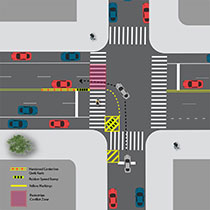
The Complete Hardened Centerline treatment includes 5 pieces of rubber curb and bollards and/or rubber speed bumps, “No Parking” markings and slow turn wedge/box markings coupled with flexible plastic posts. Starting in 2016, this treatment was installed at 53 locations to date including 132 St and Jamaica Ave in Queens.
Slow Turn Wedge
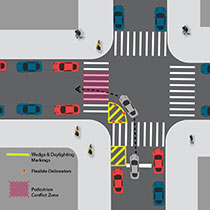
The Slow Turn Wedge treatment consists of “No Parking” markings as well as slow turn wedge/box markings coupled with flexible plastic posts or rubber speed bumps. Starting in 2016, this treatment type was installed in 49 citywide locations to date including 89 Ave & 164 St in Queens.
Bike Island Channelization
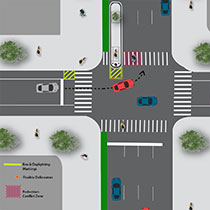
The Bike Island Channelization Treatment is only installed adjacent to existing bike islands. It consists of Bike Island Channelization box with flexible plastic posts or rubber speed bumps.This treatment was installed at 22 citywide locations starting in 2017 including 2 Ave & 25 St in Manhattan.
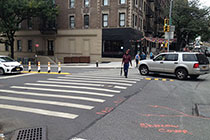
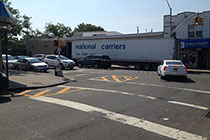
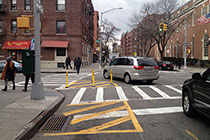
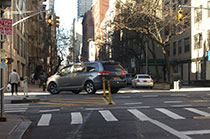
In New York City intersections where Left Turn Traffic Calming Treatments have been implemented, pedestrian injuries have decreased by 20%, declining faster than nearby comparable locations. Median left turn speeds have decreased by 19.9%. Average left turn speeds have decreased by 20.5%. 85th percentile left turn speeds have decreased by 16.7% and maximum left turn speeds have decreased by 11.7%. Vehicles are making safer turns as well; the rate of crossing the double yellow line while turning has dropped by 78.9% for locations that have a treatment extending to the stopbar and 100% for locations that have a treatment extending all the way to the crosswalk. DOT expects to see a reduction in traffic injuries once enough before/after crash data becomes available.
DOT is currently planning Phase 4 of this program where additional intersections will be selected for treatment installation across the city.